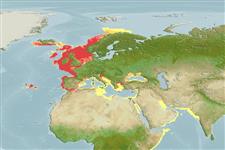Common names from other countries
Environment: milieu / climate zone / depth range / distribution range
Ecología
; salobre; rango de profundidad 0 - 521 m (Ref. 108343). Temperate; 72°N - 12°N, 19°W - 62°E
Distribución
Países | Áreas FAO | Ecosistemas | Ocurrencias, apariciones | Introducciones
Western Indian Ocean, Northeast Atlantic and the Mediterranean. Subtropical.
Length at first maturity / Tamaño / Peso / Age
Maturity: Lm ? range ? - ? cm Max length : 2.5 cm SHL macho / no sexado; (Ref. 7882)
Species' maximum length from the Belgian part of the North Sea (Ref. 7882). Inhabit sandbanks and inshore areas (Ref. 96352). Common in near-coastal zone, rarely further than 30 km off the coast. Found buried deep in almost all sediment types but prefer fine-grained to muddy substrates; rare in coarse substrates. Feeds through its long, individually separated and stretchable siphons (Ref. 7882). Known as a surface deposit feeder (Refs. 96214, 96292).
Life cycle and mating behavior
Madurez | Reproducción | Puesta | Huevos | Fecundidad | Larva
Members of the class Bivalvia are mostly gonochoric, some are protandric hermaphrodites. Life cycle: Embryos develop into free-swimming trocophore larvae, succeeded by the bivalve veliger, resembling a miniature clam.
Degraer, S., J. Wittoeck, W. Appeltans, K. Cooreman, T. Deprez, H. Hillewaert, K. Hostens, J. Mees, E. Vanden Berghe and M. Vincx. 2006. (Ref. 7882)
IUCN Red List Status (Ref. 130435)
CITES status (Ref. 108899)
Not Evaluated
Not Evaluated
Human uses
| FishSource |
Herramientas
Fuentes de Internet
Estimates based on models
Preferred temperature
(Ref.
115969): 6.7 - 13.1, mean 8.8 (based on 495 cells).
Resiliencia
Alto, población duplicada en un tiempo mínimo inferior a 15 meses (K=1.22).
Vulnerability
Low vulnerability (10 of 100).
Price category
Unknown.
